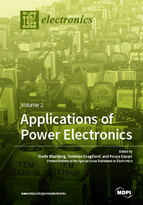Applications of Power Electronics
A special issue of Electronics (ISSN 2079-9292). This special issue belongs to the section "Power Electronics".
Deadline for manuscript submissions: closed (31 October 2018) | Viewed by 315351
Special Issue Editors
Interests: power electronics and its applications in motor drives; wind turbines; PV systems; harmonics; reliability of power electronic systems
Special Issues, Collections and Topics in MDPI journals
Interests: renewable energy; power electronics; energy storage; e-mobility; artificial intelligence; IoT-driven digitalization
Special Issues, Collections and Topics in MDPI journals
Interests: active front-end rectifiers; harmonic mitigation in adjustable-speed drives; electromagnetic interference in power electronics; high power density power electronic systems; pulsed power application
Special Issues, Collections and Topics in MDPI journals
Special Issue Information
Dear Colleagues,
Power electronics technology has found its way into many applications, from renewable energy generation (i.e., wind power and solar power) to Electrical Vehicle (EV), biomedical and small appliances, such as laptop chargers. In a near future, electrical energy is provided by power electronics and is consumed by power electronics. This, not only intensifies the role of power electronics technology in power conversion processes, but also implies that power systems are undergoing a paradigm shift, from centralized distribution to distributed generation.
One emerging application that has put an imprint on this paradigm shift is the microgrid (MG). It is a small, power electronics intensive power system, which has been gaining continually-increasing interest over the past few years, both in academia and industry. The advantages of a microgrid are that it provides higher flexibility and easier management over renewable energy sources (RESs), electronic loads and energy storage systems (ESSs), rather than interfacing those resources individually to the grid. With the rapid emergence of power electronics, the importance of microgrids in today’s society is gradually being brought to a whole new level.
The main aim of this Special Issue is to seek high-quality submissions that highlight emerging applications, address recent breakthroughs in the power electronics application-oriented design, high-power density power converters, robust and reliable power electronics technologies, smart control of power electronics at device, microgrid and system levels. The topics of interest include, but are not limited to:
- Power electronics application in renewable energies
- Power electronics application in electric vehicles
- High power density dower electronic systems
- Condition monitoring, prognostic and diagnostic of power electronics with enhanced control for reliable and robust applications
- Application of power electronics in smart DC and AC distribution systems
- Power electronics applications in electrical drives
- Power electronics applications in lighting
- Power electronics for biomedical applications
- Power electronics for microgrids
Prof. Frede Blaabjerg
Dr. Tomislav Dragicevic
Dr. Pooya Davari
Guest Editors
Manuscript Submission Information
Manuscripts should be submitted online at www.mdpi.com by registering and logging in to this website. Once you are registered, click here to go to the submission form. Manuscripts can be submitted until the deadline. All submissions that pass pre-check are peer-reviewed. Accepted papers will be published continuously in the journal (as soon as accepted) and will be listed together on the special issue website. Research articles, review articles as well as short communications are invited. For planned papers, a title and short abstract (about 100 words) can be sent to the Editorial Office for announcement on this website.
Submitted manuscripts should not have been published previously, nor be under consideration for publication elsewhere (except conference proceedings papers). All manuscripts are thoroughly refereed through a single-blind peer-review process. A guide for authors and other relevant information for submission of manuscripts is available on the Instructions for Authors page. Electronics is an international peer-reviewed open access semimonthly journal published by MDPI.
Please visit the Instructions for Authors page before submitting a manuscript. The Article Processing Charge (APC) for publication in this open access journal is 2400 CHF (Swiss Francs). Submitted papers should be well formatted and use good English. Authors may use MDPI's English editing service prior to publication or during author revisions.
Keywords
- Power electronics application in renewable energies
- Power electronics application in electric vehicles
- High power density dower electronic systems
- Condition monitoring, prognostic and diagnostic of power electronics with enhanced control for reliable and robust applications
- Application of power electronics in smart DC and AC distribution systems
- Power electronics applications in electrical drives
- Power electronics applications in lighting
- Power electronics for biomedical applications
- Power electronics for microgrids








